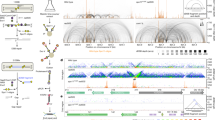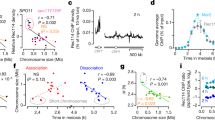Abstract
Minisatellites are tandemly repeated DNA sequences of 10–100-bp units1. Some minisatellite loci are highly unstable in the human germ line, and structural analysis of mutant alleles has suggested that repeat instability results from a recombination-based process. To provide insights into the molecular mechanism of human minisatellite instability, we developed Saccharomyces cerevisiae strains carrying alleles of the most unstable human minisatellite locus, CEB1 (ref. 2). We observed that CEB1 is destabilized in meiosis, resulting in a variety of intra- and inter-allelic gains or losses of repeat units, similar to rearrangements described in humans3. Using mutations affecting the initiation of recombination4,5 (spo11) or mismatch repair6 (msh2 pms1 ), we demonstrate that meiotic destabilization depends on the initiation of homologous recombination at nearby DNA double-strand break (DSBs) sites and involves a 'rearranged heteroduplex' intermediate. Most of the human and yeast data can be explained and unified in the context of DSB repair models7.
This is a preview of subscription content, access via your institution
Access options
Subscribe to this journal
Receive 12 print issues and online access
$209.00 per year
only $17.42 per issue
Buy this article
- Purchase on Springer Link
- Instant access to full article PDF
Prices may be subject to local taxes which are calculated during checkout




Similar content being viewed by others
References
Jeffreys, A.J., Wilson, V. & Thein, S.L. Hypervariable "minisatellite" regions in human DNA. Nature 314, 67–73 ( 1985).
Buard, J. & Vergnaud, G. Complex recombination events at the hypermutable minisatellite CEB1 (D2S90). EMBO J. 13, 3203–3210 (1994).
Buard, J., Bourdet, A., Yardley, J., Dubrova, Y. & Jeffreys, A.J. Influences of array size and homogeneity on minisatellite mutation. EMBO J. 17, 3495– 3502 (1998).
Bergerat, A. et al. An atypical topoisomerase II from Archaea with implications for meiotic recombination. Nature 386, 414 –417 (1997).
Keeney, S., Giroux, C.N. & Kleckner, N. Meiosis-specific DNA double-strand breaks are catalyzed by Spo11, a member of a widely conserved protein family. Cell 88, 375–384 (1997).
Alani, E., Reenan, R.A. & Kolodner, R.D. Interaction between mismatch repair and genetic recombination in Saccharomyces cerevisiae. Genetics 137, 19–39 (1994).
Pâques, F. & Haber, J.E. Multiple pathways of double strand break-induced recombination in Saccharomyces cerevisiae . Microbiol. Mol. Biol. Rev. 63, 349 –404 (1999).
Nicolas, A., Treco, D., Schultes, N.P. & Szostak, J.W. An initiation site for meiotic gene conversion in the yeast Saccharomyces cerevisiae. Nature 338, 35– 39 (1989).
Sun, H., Treco, D., Schultes, N.P. & Szostak, J.W. Double-strand breaks at an initiation site for meiotic gene conversion. Nature 338, 87–90 ( 1989).
de Massy, B. & Nicolas, A. The control in cis of the position and the amount of the ARG4 meiotic double-strand break of Saccharomyces cerevisiae. EMBO J. 12 , 1459–1466 (1993).
Alani, E., Padmore, R. & Kleckner, N. Analysis of wild type and rad50 mutants of yeast suggests an intimate relationship between meiotic chromosome synapsis and recombination. Cell 61, 419– 436 (1990).
Klapholz, S. & Esposito, R.E. Isolation of SPO12-1 and SPO13-1 from a natural variant of yeast that undergoes a single meiotic division. Genetics 96, 567– 588 (1980).
Baudat, F. & Nicolas, A. Clustering of meiotic double-strand breaks on yeast chromosome III. Proc. Natl Acad. Sci. USA 94, 5213–5218 (1997).
Szostak, J.W., Orr-Weaver, T.L., Rothstein, R.J. & Stahl, F.W. The double-strand-break repair model for recombination. Cell 33, 25–35 (1983).
Lichten, M. & Goldman, A.S. Meiotic recombination hotspots. Annu. Rev. Genet. 29, 423– 444 (1995).
Kirkpatrick, D.T. & Petes, T.D. Repair of DNA loops involves DNA-mismatch and nucleotide excision repair proteins. Nature 387, 929–931 ( 1997).
Sia, E.A., Kokoska, R.J., Dominska, M., Greenwell, P. & Petes, T.D. Microsatellite instability in yeast: dependence on repeat unit size and DNA mismatch repair genes. Mol. Cell. Biol. 17, 2851–2858 (1997).
Lichten, M. et al. Detection of heteroduplex DNA molecules among the products of Saccharomyces cerevisiae meiosis. Proc. Natl Acad. Sci. USA 87, 7653–7657 ( 1990).
Appelgren, H., Cederberg, H. & Rannug, U. Mutations at the human minisatellite MS32 integrated in yeast occur with high frequency in meiosis and involve complex recombination events. Mol. Gen. Genet. 256, 7– 17 (1997).
Schwacha, A. & Kleckner, N. Interhomolog bias during meiotic recombination: Meiotic functions promote a highly differentiated interhomolog only pathway. Cell 90, 1123– 1135 (1997).
Borde, V., Wu, T.C. & Lichten, M. Use of a recombination reporter insert to define meiotic recombination domains on chromosome III of Saccharomyces cerevisiae. Mol. Cell. Biol. 19, 4832–4842 (1999).
Monckton, D.G. et al. Minisatellite mutation rate variation associated with a flanking DNA sequence polymorphism. Nature Genet. 8, 162–170 (1994).
Bois, P., Collick, A., Brown, J. & Jeffreys, A.J. Human minisatellite MS32 (D1S8) displays somatic but not germline instability in transgenic mice. Hum. Mol. Genet. 6, 1565– 1571 (1997).
Keeney, S. et al. A mouse homolog of the S. cerevisiae meiotic recombination DNA transesterase Spo11p. Genomics (in press).
Romanienko, P.J. & Camerini-Otero, R.D. Cloning, characterization and localization of the mouse and human SPO11. Genomics (in press).
Jeffreys, A.J. et al. Complex gene conversion events in germline mutation at human minisatellites. Nature Genet. 6, 136– 145 (1994).
Tamaki, K., May, C.A., Dubrova, Y.E. & Jeffreys, A. Extremely complex repeat shuffling during germline mutation at human minisatellite B6.7. Hum. Mol. Genet. 8, 879–888 (1999).
Jeffreys, A.J. & Neuman, R. Somatic mutation process at a human minisatellite. Hum. Mol. Genet. 6, 129–132 (1997).
Rocco, V., de Massy, B. & Nicolas, A. The Saccharomyces cerevisiae ARG4 initiator of meiotic gene conversion and its associated double-strand DNA breaks can be inhibited by transcriptional interference. Proc. Natl Acad. Sci. USA 89, 12068–12072 ( 1992).
Vincent, R.D., Hofmann, T.J. & Zassenhaus, H.P. Sequence and expression of NUC1, the gene encoding the mitochondrial nuclease in Saccharomyces cerevisiae. Nucleic Acids Res. 16, 3297–3312 (1988).
Acknowledgements
We thank members of our laboratories for technical advice, materials and helpful discussions; K. Smith for English correction; and R. Rothstein for helpful discussion. This study was supported by an initial grant from the Groupement de Recherches et d'Etudes sur les Génomes and subsequently by the Association de Recherche contre le Cancer (ARC), the Ligue Nationale contre le Cancer, the D.G.A/D.S.P/S.T.T.C, the Human Frontier Scientific Program and the Radiobiology program of the Institut Curie. H.D. was supported by graduate student fellowships from the MNERT and the ARC.
Author information
Authors and Affiliations
Corresponding author
Supplementary information
Rights and permissions
About this article
Cite this article
Debrauwère, H., Buard, J., Tessier, J. et al. Meiotic instability of human minisatellite CEB1 in yeast requires DNA double-strand breaks. Nat Genet 23, 367–371 (1999). https://doi.org/10.1038/15557
Received:
Accepted:
Issue Date:
DOI: https://doi.org/10.1038/15557



